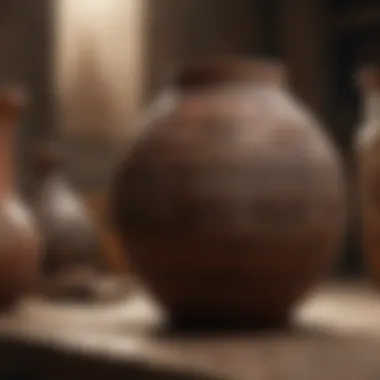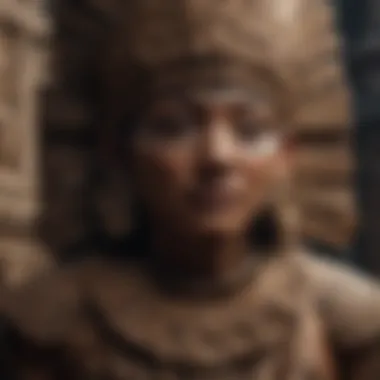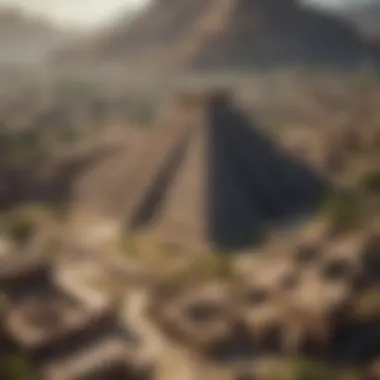Unveiling the Enigmatic Aztec Civilization: An In-Depth Exploration of Their Legacy


Nature Topic Overview
The Aztecs, an enigmatic civilization that once thrived in Mesoamerica, have left an indelible mark on history with their remarkable achievements and cultural legacy. In this comprehensive exploration, we will journey into the captivating world of the Aztecs, shedding light on their sophisticated society, awe-inspiring architecture, intricate artwork, and complex religious beliefs.
Fun Facts and Trivia
- The Aztecs founded their capital city, Tenochtitlan, on an island in the middle of Lake Texcoco, connecting the city to the mainland through a series of causeways.
- Despite not having metal tools, the Aztecs constructed impressive pyramids and temples using volcanic stone carved with remarkable precision.
- The Aztec calendar was incredibly advanced, consisting of a solar year of 365 days divided into 18 months, with each month having 20 days.
Wildlife Explorations
The Aztec civilization was deeply connected with nature, surrounded by a diverse array of flora and fauna in the valley. Jaguars, eagles, and snakes held symbolic significance in Aztec religion and were revered for their power and importance in the ecosystem. The Aztecs also cultivated an impressive range of crops, including maize, beans, and squash, showcasing their agricultural prowess.
Environmental Awareness
While the Aztecs had a deep reverence for nature, they also engaged in practices that impacted the environment, such as deforestation for agriculture. By understanding the delicate balance between human activity and the natural world, we can draw lessons for conservation and sustainability in our modern-day lives. Children can contribute to protecting nature by planting trees, reducing waste, and learning about the importance of biodiversity in ecosystems.
DIY Nature Activities
- Create a mini Aztec pyramid model using cardboard and craft materials, showcasing the architectural ingenuity of the Aztecs.
- Plant your own mini 'Three Sisters' garden with maize, beans, and squash, mimicking the Aztec agricultural tradition.
- Embark on a nature hike to observe local flora and fauna, drawing parallels to the Aztecs' deep connection with the environment.
Introduction to the Aztecs
The Aztecs, an ancient Mesoamerican civilization, hold a significant position in the realm of history and archaeology. Exploring the origins, society, and beliefs of the Aztecs unveils a rich tapestry of culture and heritage that continues to intrigue researchers worldwide. By delving into their unique societal structure and innovative advancements, we can grasp the profound impact the Aztecs had on shaping the course of history. This section serves as a gateway to comprehending the complexities and wonders encapsulated within the Aztec civilization.
Origins of the Aztec Civilization


Migration to the Valley of Mexico
The migration of the Aztecs to the Valley of Mexico marks a pivotal juncture in their historical narrative. This journey not only shaped their identity but also influenced their cultural practices and societal norms. The strategic decision to settle in the Valley of Mexico enabled the Aztecs to harness its fertile lands for agricultural purposes, laying the foundation for their prosperous civilization. Despite facing challenges along the way, the migration to this valley facilitated the growth and development of the Aztec people, creating a unique blend of tradition and adaptation.
Foundation of Tenochtitlan
The establishment of Tenochtitlan stands as a testament to the ingenuity and resilience of the Aztec civilization. Founded on an island in Lake Texcoco, Tenochtitlan represented the heart of Aztec political and cultural life. The strategic location of this city not only provided natural defenses but also enabled efficient trade and communication networks. The architectural marvels of Tenochtitlan, including its intricate canal system and grand temples, showcased the advanced engineering skills of the Aztecs. While the foundation of Tenochtitlan bore witness to struggles and conquests, it became a beacon of power and civilization in Mesoamerica.
Aztec Society and Structure
Social Classes
The hierarchical structure of Aztec society delineated clear divisions based on social status and occupation. From the noble class of tlatoani to the commoners and slaves, each stratum played a vital role in upholding the societal order. The Aztec social system reflected a balance between centralized power and individual autonomy, with emphasis placed on honor and duty within each class. By examining the dynamics of social classes within Aztec society, we gain insights into the intricate web of relationships and obligations that governed their daily lives.
Political Organization
At the helm of Aztec governance stood a complex political organization that fused religious authority with state power. The dual leadership of the tlatoani and high priests epitomized the intricate balance between secular and divine rule. The administrative prowess of the Aztec rulers extended to managing tributary states and overseeing judicial matters, ensuring the harmony and stability of their expanding empire. Through a detailed analysis of Aztec political structures, we unravel the complexities of leadership and decision-making that shaped their society.
Religious Beliefs and Practices
Polytheistic Religion
Central to the Aztec worldview was a polytheistic belief system that attributed divine significance to a multitude of gods and goddesses. Each deity represented various aspects of nature, warfare, fertility, and cosmic order, shaping the religious rituals and ceremonies of the Aztec people. The polytheistic pantheon underscored the interconnectedness of the physical and spiritual realms, emphasizing the cyclical nature of life and death within their cosmology. By exploring the nuances of Aztec polytheism, we gain a profound understanding of their spiritual worldview and ceremonial practices.
Rituals and Sacrifices
Rituals and sacrifices were core components of Aztec religious ceremonies, symbolizing the reciprocal relationship between humanity and the divine. Bloodletting rituals and offerings were made to appease the gods and ensure the continuity of the cosmos. The intricate rites surrounding death and rebirth highlighted the Aztec reverence for the cyclical nature of existence and the transience of mortal life. Through a closer examination of Aztec rituals and sacrifices, we decipher the spiritual beliefs and cultural values that underpinned their societal fabric.


Aztec Achievements and Advancements
Art and architecture were pivotal aspects of the Aztec civilization, showcasing their ingenuity and cultural sophistication. The Aztecs excelled in various artistic forms, leaving a lasting legacy of creativity and craftsmanship that continues to captivate historians and art enthusiasts alike. Their achievements in art and architecture shed light on their rich cultural heritage and advanced societal structures, positioning them as one of the most remarkable civilizations in Mesoamerican history.
Art and Architecture
Pyramids and Temples
The construction of pyramids and temples was a defining feature of Aztec architecture, symbolizing their religious devotion and architectural prowess. These monumental structures served as religious centers, administrative hubs, and visual representations of Aztec cosmology. The intricate carvings, elaborate decorations, and precise architectural design of pyramids and temples reflected the Aztec's profound spiritual beliefs and mastery in engineering. Additionally, the strategic placement of these structures within urban centers highlighted the Aztec's urban planning skills and social organization.
Pottery and Sculptures
Pottery and sculptures were integral to Aztec artistic expressions, demonstrating their affinity for intricate designs and vibrant colors. Aztec pottery was not only utilitarian but also served ceremonial and decorative purposes, with each piece showcasing meticulous craftsmanship and intricate patterns. Sculptures, predominantly depicting religious deities and mythological figures, captured the essence of Aztec belief systems and cultural narratives. The utilization of various materials such as clay, stone, and wood in sculpting provided a glimpse into Aztec artistic versatility and creativity.
Agriculture and Innovation
Chinampas (Floating Gardens)
Chinampas, or floating gardens, revolutionized agricultural practices in the marshy regions of the Aztec Empire. These man-made agricultural islands were constructed by layering mud and vegetation on wooden frames, creating fertile land for crop cultivation. The innovative concept of chinampas allowed the Aztecs to maximize their food production, ensuring sustainable farming in challenging terrains and densely populated areas. The efficient use of limited resources and advanced irrigation systems demonstrated the Aztec's ingenuity in agricultural engineering.
Food Cultivation Techniques
The Aztecs employed sophisticated food cultivation techniques, including crop rotation, terracing, and irrigation methods, to sustain their growing population. By diversifying their crops and utilizing advanced agricultural practices, such as the use of drought-resistant plants and composting, the Aztecs ensured food security and economic stability within their empire. The integration of innovative farming techniques not only boosted agricultural productivity but also facilitated trade networks and cultural exchange, underscoring the Aztec's strategic approach to sustainable food production.
Military Strength and Expansion
Conquest of Territories


The Aztec Empire's military prowess and strategic conquests were instrumental in expanding their influence and territorial control. Through well-coordinated military campaigns and alliances with local allies, the Aztecs swiftly expanded their empire, assimilating diverse populations and resources. The conquest of new territories not only bolstered the Aztec's economic power but also solidified their political dominance in Mesoamerica. The effective administration of conquered lands and populations showcased the Aztec's organizational skills and diplomatic acumen.
Military Strategies
Aztec military strategies were characterized by a combination of tactical prowess, disciplined warfare, and psychological warfare techniques. The use of specialized warrior classes, strategic alliances, and innovative combat tactics allowed the Aztecs to overcome formidable opponents and maintain their military superiority. By incorporating intelligence gathering, siege warfare, and defensive fortifications, the Aztecs secured their borders and negotiated strategic advantages in conflicts. The effective application of military strategies solidified the Aztec Empire's reputation as a formidable military force in ancient Mesoamerica.
Decline and Conquest of the Aztecs
In the grand narrative of uncovering the enigmatic Aztec civilization, the phase of Decline and Conquest stands as a pivotal chapter. It intricately weaves together the gripping tale of encounters with the relentless Spanish Conquistadors, precipitating a seismic shift in the tapestry of Aztec history. This section meticulously navigates through the tumultuous events leading to the eventual downfall of the Aztec empire, exploring the multifaceted elements that contributed to its disintegration.
Encounters with Spanish Conquistadors
Hernan Cortes and the Conquest of Mexico
Dissecting the essence of Hernan Cortes' audacious escapades into the heart of Mexico unveils a saga marked by ambition, cunning strategies, and enduring consequences. His calculated maneuvers, coupled with his charismatic leadership, bore witness to a conquest that reverberated across continents. The conquest of Mexico spearheaded by Cortes not only redefined the course of Aztec history but also left an indelible mark on the annals of conquest narratives worldwide. The intersection of Cortes' unyielding determination and strategic acumen encapsulates a narrative that continues to captivate historians, underlining its significance in perpetuating historical discourse.
Fall of Tenochtitlan
The poignant chapter of the Fall of Tenochtitlan serves as a poignant reminder of the fragility of empires and the cataclysmic impact of external forces. The siege and eventual capitulation of Tenochtitlan symbolize the denouement of an era characterized by defiance and resilience. Understanding the strategic missteps, the battles fought, and the ultimate demise of Tenochtitlan offers profound insights into the intricacies of conquest and dominance. The fall of Tenochtitlan not only heralded the end of an epoch but also laid the groundwork for a new epoch riddled with colonial legacies.
Factors Contributing to the Downfall
Diseases and Warfare
Amidst the echoes of conflict and conquest, the insidious interplay between diseases and warfare emerges as a defining factor in the unraveling of the Aztec empire. The onslaught of foreign diseases, coupled with the strategic machinations of warfare, precipitated a cataclysmic convergence that eroded the foundations of Aztec resilience. Analyzing the symbiotic relationship between diseases and warfare unravels a complex tapestry of vulnerabilities and strategic implications that reverberate through time.
Alliances with Indigenous Tribes
The confluence of alliances with indigenous tribes amidst the tumult of conquest presents a nuanced perspective on the dynamics of power and resistance. The strategic collaborations forged between disparate factions delineate a narrative of diplomatic intrigue and tactical acumen. Delving into the role of alliances within the context of Aztec downfall sheds light on the intricate web of loyalties, betrayals, and allegiances that shaped the course of history, underscoring the strategic imperative of coalition-building.
Legacy of the Aztecs
Embarking on a journey through the ethereal realms of Aztec legacy unveils a tapestry woven with cultural influences and archaeological marvels. The enduring footprint of Aztec cultural influences reverberates through art, language, and societal structures, transcending temporal boundaries to resonate with contemporary sensibilities. Exploring the archaeological discoveries scattered amidst the vestiges of Aztec civilization unveils a treasure trove of insights into their technological prowess and cultural ethos, offering a profound glimpse into a bygone era steeped in mystique and brilliance.







